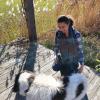Groups
Looking for a place to discuss camera trap troubleshooting, compare models, collaborate with members working with other technologies like machine learning and bioacoustics, or share and exchange data from your camera trap research? Get involved in our Camera Traps group! All are welcome whether you are new to camera trapping, have expertise from the field to share, or are curious about how your skill sets can help those working with camera traps.
You’re invited to the WILDLABS Variety Hour, a monthly event that connects you to conservation tech's most exciting projects, research, and ideas. We can't wait to bring you a whole new season of speakers and discussions!
Human-wildlife conflict is a significant challenge that only grows as habitats shrink and other issues like climate change alter the natural world. Technologies like biologging gear have become essential for proactively addressing human-wildlife conflict before it escalates, and tech projects that seek to understand population ranges and behaviour can help people learn to live with wildlife as part of our own environments. If you're interested in using technology to prevent human-wildlife conflict, this group is the place for you!
An update on @Alasdair and @adanger24's HWC project
Just starting your conservation tech career path? Our Early Career group is the best place to network, chat about your master's projects, and seek advice from your peers and those who have been down this path before! Join now to get to know community members and students from around the world!
You’re invited to the WILDLABS Variety Hour, a monthly event that connects you to conservation tech's most exciting projects, research, and ideas. We can't wait to bring you a whole new season of speakers and discussions!
This group is a place to share low-cost, open-source devices for conservation; describe how they are being used, including what needs they are addressing and how they fit in to the wider conservation tech market; identify the obstacles in advancing the capacity of these technologies; and to discuss the future of these solutions - particularly their sustainability and how best to collaborate moving forward.
In a recent publication we tested Underwater Passive Acoustic Monitoring (UPAM) as a feasible non-invasive technique to study the calling behavior of therathened aquatic Andean frogs under natural conditions in the extreme environments of PUNA in the central Andes of Argentina
Wildlife crime is a complicated challenge, so it's no wonder that the conservation technology community has explored solutions with every type of technology, all with the aim of predicting, preventing, and stopping crimes like poaching, illegal logging and fishing, and the sale of animal products like ivory. Join our Wildlife Crime group to meet others who are working on potential solutions to this global challenge and to add your own expertise to the conversation!
Catch up on the conservation tech discussions and events that happened during World Wildlife Day 2024!
Acoustic monitoring is one of our biggest and most active groups, with members collecting, analysing, and interpreting acoustic data from across species, ecosystems, and applications, from animal vocalizations to sounds from our natural and built environment
In a recent publication we tested Underwater Passive Acoustic Monitoring (UPAM) as a feasible non-invasive technique to study the calling behavior of therathened aquatic Andean frogs under natural conditions in the extreme environments of PUNA in the central Andes of Argentina
Over the last few years the conservation movement has been enthusiastically deploying new technologies that make it possible to observe and protect the natural world in ways once unimaginable. But are there any potential risks we need to consider as we deploy the new, exciting technologies?
Listen in on our interview with human-predator conflict expert, Gabi Fleury and gain a deeper understanding of the importance of holistic, ethical and community-led approaches to developing tech solutions for conservation.
The software and apps used and built by the conservation tech community are as varied as the species and habitats we work to protect. From fighting wildlife crime to collecting and analyzing data to engaging the general public with unique storytelling, apps, software, and mobile games are playing an increasingly large role in our work. Whether you're already well-versed in the world of software, or you're a hardware expert looking for guidance from the other side of the conservation tech field, this group will have interesting discussions, resources, and ideas to offer.
In a recent publication we tested Underwater Passive Acoustic Monitoring (UPAM) as a feasible non-invasive technique to study the calling behavior of therathened aquatic Andean frogs under natural conditions in the extreme environments of PUNA in the central Andes of Argentina
Used to pick up signals from tracking gear on the ground, collect images of wildlife and habitats from the air, gather acoustic data with specialized hydrophones, or even collect snot samples from whales' blowholes, drones are capable of collecting high-resolution data quickly, noninvasively, and at relatively low cost.
Catch up on the conservation tech discussions and events that happened during World Wildlife Day 2024!
Real-time tracking of animal movements is enabling more effective and efficient wildlife monitoring for management, security, and research. As devices get smaller and prices drop, the possibilities for using biologging on a larger scale have grown, and so have the possibilities for increasing customisation to meet specific research needs. Likewise, real-time tracking of illegal wildlife trade, timber, and fish products as they move from source to consumer can shed light on trafficking routes and actors, as well as support enforcement, making tracking gear a powerful tool beyond the field.
You’re invited to the WILDLABS Variety Hour, a monthly event that connects you to conservation tech's most exciting projects, research, and ideas. We can't wait to bring you a whole new season of speakers and discussions!
Want to talk about sensors that don't quite fit into any of our tech-specific groups? This is the place to post! From temperature and humidity to airflow and pressure sensors, there are many environmental sensing tools that can add valuable data to core conservation monitoring technologies. With the increasing availability of low-cost, open-source options, we've seen growing interest in integrating these kinds of low bandwidth sensors into existing tools. What kinds of sensors are you working with?
In a recent publication we tested Underwater Passive Acoustic Monitoring (UPAM) as a feasible non-invasive technique to study the calling behavior of therathened aquatic Andean frogs under natural conditions in the extreme environments of PUNA in the central Andes of Argentina
Welcome to the official group forum for our virtual course, Build Your Own Data Logger. This is your space to engage with course instructors Akiba and Jacinta from Freaklabs, find help and resources for each module, collaborate and chat with your fellow course participants, and share your progress on your own Data Logger project!
Welcome to the eighth and final module of our Build Your Own Data Logger virtual course. We’ve built, coded and tested our data logger. Now we’re taking it into the field.
Camera trapping for insects is becoming a reality using advances in camera, AI, and autonomous systems technologies. This group discusses the latest advances, shares experiences, and offers a space for anyone interested in the technology, from beginners to experts.
We are a group of students at UW-Madison who have built a working prototype for insect imaging. The light trap is aimed at photographing aquatic insects.
Collections
Keep track of the resources that matter to you! Collections let you save, organise, and share content from all over the WILDLABS community. Create your first collection by clicking on the bookmark icon wherever you see it.
Kishore Panaganti's Content
Fellowship Reviews
Active Applications
All Assigned Applications
Fellowship Applications
As a fellowship administrator, you can manage applications.
Match by country
Match by Technology
Match by Ecosystem














































































Kishore Panaganti's Comments